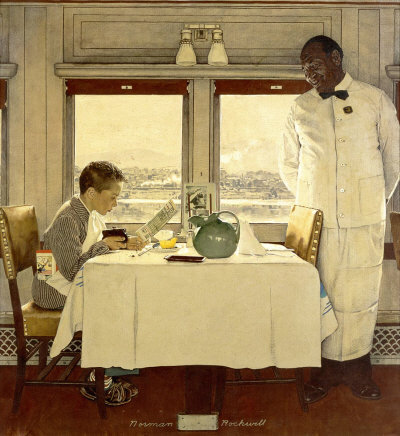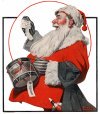 |
||||||||||||||
Boy In Dining Car by Norman Rockwell
December 7, 1946 Issue of The Saturday Evening PostBoy In Dining Car, a Norman Rockwell painting, appeared on the cover of The Saturday Evening Post published December 7, 1946. This is another favorite of Rockwell collectors, a classic enduring image of the world Rockwell painted. Alternate titles for this painting are New York Central Diner and The Tip. This painting was Rockwell's 243rd overall out of 322 total paintings that were published on the cover of the Saturday Evening Post. Rockwell's career with the Post spanned 47 years, from his first cover illustration, Boy With Baby Carriage in 1916 to his last, Portrait of John F. Kennedy, in 1963. This was also the seventh cover for The Post in 1946. In 1946, there were seven Norman Rockwell Saturday Evening Post covers published. The original oil on canvas painting, 38 x 36 inches or 96.5 x 91.5 cm, is part of the collection of the Norman Rockwell Museum of Stockbridge, MA. A charcoal, colored pencil and pencil on paper on board study, 38 x 35 inches or 96.5 x 88.9 cm, brought $241,000 at auction on November 28, 2007 at Sotheby's in New York City. It exceeded its pre-auction estimate of $80,000 to $120,000. The study was signed "To D. S. MacBride / Sincerely / Norman / Rockwell." Boy In Dining Car is also included in the traveling exhibition, American Chronicles: The Art Of Norman Rockwell. I was fortunate enough to see the original painting in person during January 2011 in Raleigh, North Carolina at the North Carolina Museum of Art. This painting also appears in eight Rockwell commentary books. It appears:
Several studies also appear in the Norman Rockwell Catalogue on page 172. Photographs taken during the staging of the composition of the painting appear on pages 100 and 101 of Norman Rockwell: Behind the Camera by Ron Schick Pristine original copies of this magazine cover routinely sell for big bucks on eBay, when it is offered. And to think it only cost ten cents originally! And it was mint condition then, too. Boy In Dining CarGiclee Prints on Archival Paper: In this painting, Norman Rockwell shows us a young boy's first experience at figuring the tip for service received. We can assume that he received excellent service. The waiter appears to be an experienced server. Rockwell used a dining car provided by the New York Central's Lake Shore Limited as his background. Rockwell captured a moment in his own son's life that he thought would touch a familiar chord. Rockwell was inspired by Hablot Knight Browne’s classic illustration of a similar scene in Charles Dickens’ 1850 novel David Copperfield. Rockwell's father entertained the family by reading aloud passages from Dickens, and young Norman first experimented at art by drawing scenes from those readings. So Boy In Dining Car is coming full circle for Rockwell from his roots. The painting accurately describes a young boy's first effort at calculating his waiter’s tip. Some of us still have to get out our calculators to do that math. Rockwell, always the stickler for authentic detail, needed a real dining car to photograph and paint. The New York Central rail line diverted one of its dining cars to New York City for Rockwell's photo shoot. Rockwell, along with then ten-year-old son Peter went to the railyard for a model shoot. When he saw the dining car, Rockwell decided that the newer car, called the 20th Century Limited, looked too modern and did not posess the character he sought for the painting. He requested an older model dining car. As far as finding the ideal model for the waiter, the first three models interviewed also proved to be not suited for that role as Rockwell pictured it. The following week when the older car with more character arrived, so did his waiter. The waiter who arrived with the older car was a twenty-eight year veteran waiter. Now Rockwell had all the components in place and got down to work choreographing the photo shoot. The dining car was somewhat narrow. The photos taken to compose the painting could not capture the waiter or the background in a single shot. The photo session was taken during "the hottest day of the year," according to Peter Rockwell, who was chosen from four boys who had modeled for the role. Boy In Dining Car was only one of 322 Norman Rockwell Saturday Evening Post covers; Here is the list of Norman Rockwell Saturday Evening Post cover illustrations.
Here is the complete list of all Norman Rockwell magazine covers. The postcard with a picture of a train on it, visible leaning against the wall, was included by Rockwell to show his appreciation for the efforts of the Railroad. The train was the company's pride and joy, the 20th Century Limited locomotive. In addition the Saturday Evening Post credited the railroad in the caption for the painting. This was equivalent to $10,000 worth of free publicity for the New York Central railroad.
Norman Rockwell's Boy In Dining Car (1946)
Remember to check back often.
|
Norman Rockwell Quotes:I'll never have enough time to paint all the pictures I'd like to. No man with a conscience can just bat out illustrations. He's got to put all his talent and feeling into them! Some people have been kind enough to call me a fine artist. I've always called myself an illustrator. I'm not sure what the difference is. All I know is that whatever type of work I do, I try to give it my very best. Art has been my life. Right from the beginning, I always strived to capture everything I saw as completely as possible. The secret to so many artists living so long is that every painting is a new adventure. So, you see, they're always looking ahead to something new and exciting. The secret is not to look back. I can take a lot of pats on the back. I love it when I get admiring letters from people. And, of course, I'd love it if the critics would notice me, too. You must first spend some time getting your model to relax. Then you'll get a natural expression. More at BrainyQuote. Rockwell Favorites
|
|||||||||||||
|
|
||||||||||||||
|
Images are copyrighted by their respective copyright holders. Graphic Files Protected by Digimarc. Contact us for details about using our articles on your website. The only requirements are an acknowledgement and a link.
|
||||||||||||||
















